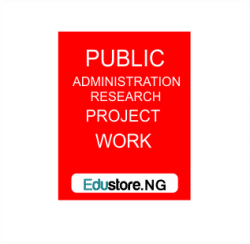WOMEN AND NATIONAL DEVELOPMENT
(A CASE STUDY OF FAMILY SUPPORT)
This study is to access to activities of women and national development particularly in Njikoka Local Government Area of Anambra State. The cordial objective of this study is to examine and investigate the performance of family support programme in the above mentioned local government area. To achieve this aim, for hypothesis were formulated. They tried to national development or not, the constructing factors militating against their effort, why most of their contributions are not usually acknowledged and achievement so far on the projects. The data used wee oral interview, library instrument, participant observation and sampling technique. After a thorough research with the use of interview and hosts of others, the hypothesis was accepted. It was found that women can effectively contribute to national development in Nigeria that is the idea behind this more will intended to establish and recreate the efforts being made by some capable women to engender roles of women folk for family and national development. It is also undertaken to determine the impact of women’s programmes in mobilizing women to contribute to national development in Nigeria. It was recommended that the efforts of women toward development should be accessed and encouraged and be motivated so as to brought about national development. In conclusion women’s effort in the national as a whole should be acknowledged their right should not be deprived of them, but mobilized and accessed in order to contribute enhancing to national development in Nigeria.
TABLE CONTENTS
Title page- – – – – – – – – i
Certification page – – – – – – – ii
Dedication – – – – – – – – iii
Acknowledgement – – – – – – – iv
Table of content – – – – – – – v
Abstract – – – – – – – – – vi
CHAPTER ONE
1.0 INTRODUTION – – – – – – 1
1.1 Background of the study – – – – – 10
1.2 Statement of the study – – – – – 13
1.3 Purpose of the study – – – – – – 15
1.4 Hypothesis – – – – – – – 16
1.5 Significance of the study – – – – – 16
1.6 Scope of the study – – – – – – 18
1.7 Limitation – – – – – – – 18
1.8 Definition of terms – – – – – – 20
CHAPTER TWO
2.0 METHODOLOGY – – – – – – 32
2.1 Brief outline of the study- – – – – 33
CHAPTER THREE
3.1 Research Method Used – – – – – 69
3.2 Sources of data – – – – – – 70
3.3 Instrument for data collection – – – – 70
3.4 Population of the study – – – – – 70
3.5 Sample of the study- – – – – – 71
3.6 Questionnaire administration and collection – 71
3.7 Method of data analysis – – – – – 73
CHAPTER FOUR
4.0 Data presentational and analysis findings – 74
CHAPTER FIVE
5.0 Summary – – – – – – – – 82
5.1 Recommendation – – – – – – 84
5.2 Conclusion – – – – – – – 86
Questionnaire – – – – – – – 90
Appendix – – – – – – – – 91
References – – – – – – – 92
CHAPTER ONE
1.0 INTROUCTION
From the beginning of time women have made to be a vital instrument of social development in almost all capacities of human engagement. The biblical injunction that women shell be man’s helper has lured various service and capacities for instance they have laboured in the house as the mother and housewives. They have a time extending their roles a cross the frontiers of a house-wife. At sometimes many women from age to age have proved to be invaluable silent counselors by their husbands. By thus is meat that some of the policy decision of their people are the brain child of their wives who inform their husbands of the decision that sometimes convey public impacts. That is not all.
Women are also found to be involved in some trivial but equally essential services to their families and the general society. These include harvesting and processing farm products for house holds consumption or assisting their make counterparts in farming. In fact, the term “assisting” might be misapplied have, because in the practical aspect, the African women engages in more tedious labour in the farm than we husband, most work done by men are easer going and work at shorter duration compared to the women tasks. For instance, men’s work are usually confined to cleaning an area for cultivation and even her sometime with women’s assistance and then cultivation. The rest of the work which is more labourious is entirely shifted to the women. These includes planting of the crop weeding and he general technical supervision of the farm.
In spite of these contribution, instead the form of trend that women have been suppressed to exploitation, subjected to psychological and in some instance physical assaui. (C.F. Iyayi,199:8)
Today, however the situation has assumed a different dimension as women are enjoying more freedom in our economic and technological complexities. It dawned on women that their intention is no longer suspected to menial Jobs but that also have a crucial role to play in positive development in Nigeria. Among the antecedents of these changes as they occurred in a historical sequence are as follows
In 1946, the united organization created the commission on the status of women in recognition of the disadvantage status of women.
The charter include the promotion of equality of opportunities regardless of race sex etc. in 1907, the general discrimination of education and in 1967, the united Nation general Assembly adopted a declaration on the elimination against women as an elaboration of the universal declaration of human right.
In 1972, the U. N general Assembly declared 1975 an internal women’s year. This led to the first world conference held in Copenhagen in 1975 where action was to be intensified to promote equally between men and women and to ensure the full integration of women in total development and effort and also increase their contribution to the strengthening of place. Another conference on international year for women oathining a ten year plan of action on “equality development and was held in Mexico.
In 1979, the U.N. took a resolution against any form of discrimination against women in Nigeria, the idea belong women originated from the interest that evolved during the founding members believed that the liberation of women cannot be fully achieved outside the context of liberating the oppressed and the poor majority in the country.
In 1685, the world conference on women was held in Nairobi Kenya, at a very ethical period when Nigeria was undergoing econ depression. Based on the 1985 forward-looking strategies for women, the federal government of Nigeria organization awareness campaigns, workshops, seminars and rallies to mobilize women and teenage girls.
Thus resulted in creating activities for both urban and rural women.
In 1989, United Nations educational scientific and cultural organization (UNESCO) stated that “human kind in entering the 21stcentury with a list of unresolved global issues on it’s agenda……women comprising half of the world’s population cannot be divorced from active participation in solving those global problem. This implies that women are entitled to equitable involvement in decision making in solving our problem.
Between August 27 and September 3, 1995, the forth U.N. conference on women was held in Belgium, China, it was the fourth and the largest world conference on women in the context of equality and sustainable development.
All these development illustrated human effort at redefining women status in the human folk. They bring with them corresponding challenges and responding challenges and responsibilities.
Moreso, it is intentionally accepted that the family is the bedrock of every society.
GET COMPLETE PROJECT MATERIAL (FILE)s NOW! >>>
DOWNLOAD COMPLETE WORK- For Reference Only: Materials are for research, citation, and idea generation purposes and not for submission as your original final year project work.
- Avoid Plagiarism: Do not copy or submit this content as your own project. Doing so may result in academic consequences.
- Use as a Framework: This complete project research material should guide the development of your own final year project work.
- Academic Access: This platform is designed to reduce the stress of visiting school libraries by providing easy access to research materials.
- Institutional Support: Tertiary institutions encourage the review of previous academic works such as journals and theses.
- Open Education: The site is maintained through paid subscriptions to continue offering open access educational resources.





